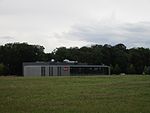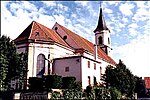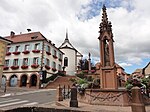Griesheim-près-Molsheim
Bas-Rhin geography stubsCommunes of Bas-RhinPages including recorded pronunciationsPages with French IPA

Griesheim-près-Molsheim (French pronunciation: [ɡʁisaim pʁɛ mɔlsaim] , literally Griesheim near Molsheim; German: Griesheim bei Molsheim) is a commune in the Bas-Rhin department in Grand Est in north-eastern France.It is one of nine member communes of the Communauté de communes des Portes de Rosheim.
Excerpt from the Wikipedia article Griesheim-près-Molsheim (License: CC BY-SA 3.0, Authors, Images).Griesheim-près-Molsheim
Rue de Duttlenheim, Molsheim
Geographical coordinates (GPS) Address Nearby Places Show on map
Geographical coordinates (GPS)
| Latitude | Longitude |
|---|---|
| N 48.5039 ° | E 7.5322 ° |
Address
Rue de Duttlenheim 214
67870 Molsheim
Grand Est, France
Open on Google Maps










